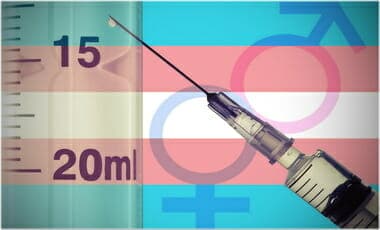(See my “Detransition Tag” for all related posts)
- The research did not look at ‘bottom’ surgeries among minors, which involve removing or modifying youngsters’ sex organs. These procedures are also thought to have risen in recent years. (DAILY MAIL)

The deeper you dig in the dark warrens of adolescent transgender medicine, the more convinced you become that the doctors who operate on young girls are criminal or insane or both.
I know that sounds extreme. But how can a decent person read the bare statistics in a recent article in one of the world’s leading paediatrics journals without feeling rage?
A brief report from four doctors at Vanderbilt University, “Gender-Affirming Chest Reconstruction Among Transgender and Gender-Diverse Adolescents in the US From 2016 to 2019” appeared in JAMA PEDIATRICS earlier this week. It is “the largest investigation to date of gender-affirming chest reconstruction in a pediatric population” to date.
The researchers found that the incidence of “gender-affirming chest reconstruction” surgery for children under 18 – better known as double mastectomies or “top jobs” — increased by 389 percent between 2016 and 2019. (These “chest reconstructions” included some boys who presumably wanted breast implants – but these were only 1.4 percent.)
An estimated 1,130 “top jobs” were performed during those four years on girls as young as 12. What kind of doctor amputates the healthy breasts of a 12-year-old girl?
According to the data, based on the Nationwide Ambulatory Surgery Sample, the Vanderbilt doctors calculated that 5.5 percent of the children were under 14, 21.5 percent under 15, and 56 percent under 16.
It gets worse.
Through the distorted lens of the billion-dollar sex-reassignment surgery industry, “top jobs” might make sense as the last step in the gender-affirmation template. After a gender-dysphoric girl has experimented with living in a male body for months or years, she wants her chest to look masculine. She proceeds through the following steps:
- I know I’m a boy in a girl’s body.
- I need social affirmation.
- I need puberty blockers.
- I need cross-sex hormones.
- I need a double mastectomy.
But according to the figures compiled by the Vanderbilt doctors, only 19.9 percent of these girls had hormone therapy before surgery. That means that the overwhelming majority of these young girls – 80.1 percent – had their breasts amputated without attempting to masculinise their bodies.
[….]
Amputation without hormone therapy makes no sense even in the Alice in Wonderland universe of transgender medicine. It is sheer mutilation. It is worse than prescribing liposuction for a 12-year-old suffering from anorexia nervosa. Or amputating limbs or severing spinal cords for people suffering from Body Integrity Identity Disorder. Where are the studies which show that “top jobs” alone will solve girls’ gender dysphoria?
Furthermore, more than a third of the girls had been diagnosed with anxiety or depression. (The study fails to mention autism, which is often implicated in gender dysphoria.) What kind of surgeon amputates the breasts of a mentally-ill teenager?
[….]
The data in this study are already nearly three years old. How many more girls will be maimed for life by sociopathic surgeons before Americans wake up to this grotesque violation of human rights?
Detransitioned teen, Layla Jane, sues Kaiser Permanente after getting double mastectomy at age 13:
DAILY MAIL has this on Layla Jane (hat-tip GATEWAY PUNDIT):
According to legal papers, Layla experienced moodiness, anxiety, gender confusion and anger issues as a child. At age 11 learned about radical transgender ideology and went online to learn more about the new trend.
She self-diagnosed that she was a boy and believed transitioning would solve her mental health problems.
According to the suit, doctors at the Permanente Medical Group and Kaiser Foundation Hospitals rushed her on to cross-sex hormones and a double mastectomy without properly assessing her mental health problems.
Her evaluations lasted only 30 minutes and 75 minutes, records show.
Legal papers identify the carers as Susanne Watson, a psychiatrist in Oakland, San Francisco-based plastic surgeon Winnie Tong, and Lisa Taylor, a pediatric endocrinologist in Oakland.
They are accused of ‘intentional, malicious, and oppressive concealment of important information and false representations’ that saw Layla pushed into the procedures.
It’s claimed they presented Layla Jane and her parents with a terrifying choice: ‘Would you rather have a live son, or a dead daughter?’ — language that echoes complaints from other detransitioners across the US.
‘These are decisions I will have to live with for the rest of my life,’ Layla said in a statement.
‘I’m ready to join the growing group of detransitioners so that no other child has to go through the torment I went through at the hands of doctors I should have been able to trust.’
In the above video Chloe Cole is mentioned:
Chloe Cole—joined by Harmeet Dhillon who is representing her—talks about suing the doctors who originally transitioned her: “It’s a medical malpractice case. I want to hold the adults who put me in harm’s way accountable.”





